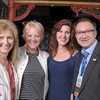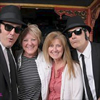Gems from ALA

It can be quite time consuming just trying to determine what sessions to attend while at ALA’s annual conference. Of the sessions I attended this year there were a few that stand out as gems for me.
Gem #1
From Outcomes to Outputs: Measuring What Matters there were 3 distinct topics: The Edge Initiative, Library Journal Index of Public Library Services and Charlotte Mecklenburg Library’s new approach to measuring impact of Summer Reading.
The gem from this session, for me, was David Singleton with Charlotte Mecklenburg as he described the library's response when realized “they had critical needs to evaluate outcomes and a need to tell the story of the Library’s value and relevance to the community.” They asked themselves two key questions: What does success look like? How does this success help tell the library’s story? You can visit their website to learn more about their approach.
Gem #2
Storytelling Mojo: Creating the 21st Century Library Narrative, Michael Margolis with http://www.getstoried.com was the presenter.
There were, for me, many gems in this session. He opened by reminding us that public libraries were originally started to make information available and free. He said “we’ve been successful now since information is free. We’ve won the battle so this is something to embrace."
"Books are no more threatened by Kindle than stairs by elevators – Stephen Fry
Everybody is a storyteller. Everybody has a story worth telling. So, this is important to keep in mind especially with social media. “Those who tell the stories rule the world.” – Hopi proverb
To be a creator you are finding a point of view. We respond to people with points of view. Librarians help people find their voice or point of view. For stories you have to go where the energy is. The best stories are paradoxes. Stories reveal the invisible lines of connection. We naturally look for ourselves in stories and the key is that you have to feel safe.
When the world is changing you have the opportunity and the expectation to tell change and tell your story.
Story Strategies:
- Motivations: In service to Whom? Why are you telling this story. It needs to go beyond self interest
- Audience: What's on my mind? It's hard to do this when you think of your audience in abstraction. Get specific, come up with an individual - give them an avatar, age, name...
- Stakes: Why Should I care? Talk about this as a unique window of time or opportunity in time due to the changes in society.
- Trust: How Can I believe you? Describe the program or initiative so the audience can trust you know what you're doing.
- Emotion: Does this story make me feel good?
- Resonance: Do I belong in this story?
People don’t buy the product, object, or brand. They buy the story that’s attached to it.
View the powerpoint presentation of this session.
Gem #3
Beyond Brainstorming: Making More Effective Decisions presented by Joan Frye Williams, a library futurist. This presenter was funny, entertaining and offered a thoughtful approach to making more effective deisions.
Solve the right problem
- Sometime the presenting problem is the decision that needs to be made but that isn't the case.
- Understanding your role - voice, vote, or veto?
- Understand any fixed criteria
- Find out what's really going on
- Look for alternate explanations for your current state
- Identify a preferred future state -- what does good look like and do we all agree on that state?
- Absence of conflict is not always good -- do we have safe ways to disagree?
- it's not your job to make everyone happy -- it would guarantee crap decisions.
Broaden your options
- Don't start with a yes/no decisions. This type of decision comes at the end of the process. There is more than one right answer.
- Look beyond the familiar - if everything on your list you are comfortable with you probably don't have enough options
- Try reverse brainstorming -- how can we make sure we won't be successful at____
- Test your assumptions
- Gather hard data
- Look for patterns
- Think about service life cycles -- is this reaching the end of its normal life cycle
- Project more than one future
- Don't canonize the past - sometimes that is the last time a person felt competent
- Assess the true odds
- Treat exceptions as exceptions
- Just because there's a grant - this is not a good decision
Strengthen each option
- then re-examine each of them
- work in parallel to flesh out and strengthen the options (ask "how we would go about making this approach a success?")
- Exchange options (among the teams) and strengthen the options further
- Try combining the best elements of multiple options
- Do a pre-mortem (this is as strong as we can get it now we're going to look a year in the future. We are going to implement it and it is dead. Examine what killed it?)
- Leverage any objections.
- terms to use "(Good point. How can we strengthen it so that won't happen?) How can we address it?"
- Assume positive intent (assume the person offering a suggestion actually wants it to work. That means no attribution to motivation. Give them credit for wanting it to be good. Sometimes even the people you don't like have good points.)
- Yes, and... (do not say 'yes, but...' since the word 'but' dismisses the idea)
- Develop multiple viable paths
Get some distance before deciding
- allow time for reflection.
- a good way to help is to say if you have to decide now "How will you feel about this in 10 minutes? in ...minutes ...months ....years?"
- What would your successor do? It is surprising how freeing this can be.
- What would your role model do?
- What would you advise someone just starting out?
- How would you advise your best friend?
- Quit Taking It Personally (Q-tip)
Make your decision
- Yes/No
- Rock, paper, scissors
- Stay focused on results
- What else could you do if you didn't do this?
- What would doing this say about who you are?
Gem #4
This year several of us were invited to a Recorded Books event at the House of Blues for some food, conversation and music. Recorded Books is the distributor of Zinio For Libraries. We got to spend time with our rep (who you may have met when he conducted the Zinio training classes offered at MLS in June), eat, as well as listen and dance to the “Blues Brothers’. The professional photographer captured some of our time there.
 |
 |
 |
 |
Kay Bauman is the Deputy Executive Director for Library Operations. She has been a MLS family member for over 30 years. She can be reached at [email protected].
- Log in to post comments

Comments
Thank you for sharing these gems. I love your presentation, and the photos are terrific.
The Story Mojo presentation was spot on for how to tell our library story. Thanks a bunch for sharing!
On that presenter's website Get Storied is a link to a TED video of him sharing 3 pearls of entrepreneurial storytelling: Michael Margolis at TEDxMillRiver By viewing that video you may get a better idea of his points.